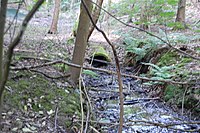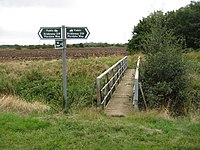Mardyke (river)

The Mardyke (sometimes, but less frequently, Mar Dyke, occasionally Mardike) is a small river I Essex which flows into the River Thames at Purfleet, close to the Queen Elizabeth II Bridge which bears the M25 motorway over the Thames. In part, thr Mardyke forms the boundary between the Essex hundreds of Barstable and Chafford.
Course

The main source of the Mardyke is in Holden's Wood between Great Warley and Little Warley.[1] It flows roughly 11 miles from the source to the Tideway of the Thames at Purfleet, close to the Queen Elizabeth II Bridge.
There are two tributaries flowing south from Thorndon Country Park, in the grounds of Thorndon Hall. One of these flows south from Old Hall Pond. The pond has a sluice gate that could be opened to allow the water to flow over artificial waterfall - the sort of water feature popular with landscape gardners such as Lancelot "Capability" Brown who landscaped the grounds of Thorndon Hall in the 18th century, although the pond itself dates from the 13th century.[2] Another tributory flows west from Dunton Plotlands section of the Langdon Nature Reserve in Langdon Hills and another flows east from Upminster.
Name
The name "Mardyke" is from Old English and means "boundary ditch".[3] It is mentioned in an Anglo-Saxon charter dated 1062 (S 1036) as part of the boundary for Upminster, although this charter is probably a post-conquest forgery.[4] It has also been called "the Flete"[5] (which in the form fleot is an Old English word for a small estuary where ships may float at anchor). More simply it is known as "the brook".[4]
One of the Mardyke's tributaries flows from Childerditch. This name appears as "celta" in a 7th-century charter (S 1246). Celta may be the pre-Saxon name for the ditch which flows into the Mardyke[6] and may also be an early name for the Mardyke itself.[7]
History
Between Stifford and the Rainham marshes where the Mardyke enters the Thames, the river flows through a relatively steep sided valley formed by an earlier position of the Thames.[8] There is ancient woodland on the valley slopes and the land close to the river was used for grazing. Pollen evidence from the Mardyke valley shows that there was woodland regeneration at the end of the Roman period and into the early Anglo-Saxon period.[9]
There is a substantial bridge over the Mardyke at Stifford. A mediæval stone bridge was built in 1487, although this has subsequently been replaced more than once.[10] Various archaeological objects have been found in the Mardyke close to Stifford Bridge. These include a hammerstone, a small sword[11] and a Pilgrim badge.[12]
There was a water mill on the Mardyke at Purfleet in the 14th century, that was owned by the Knights Templar.[13] From about 1760, sluice gates protected the lowlying land through which the Mardyke flows from the tidal and saline Thames.
In the 19th century and earlier, the Mardyke was navigable to Bulphan. Using a network of drainage ditches, manure from London was brought to local farms and agricultural produce taken to market.[14] In the 18th century, when the river was still tidal, it may hav been navigable as far as Orsett Hall at high tide.[15]
Recreational area


The river gives its name to the Mardyke Valley, a project aimed at increasing the appreciation and usage of recreational land around the Mardyke,[16] and which is a part of the Thames Chase Community Forest.[17] The project includes a seven-mile riverside walk known as the Mardyke Way, running from Ship Lane, Aveley to Orsett Fen.[18] In 2005, the project received a grant of over £600,000 from the Heritage Lottery Fund.[19]
The Mardyke Way passes through Davy Down, a 32-acre riverside park between Lakeside Shopping Centre and South Ockendon that was opened in 1993.[20] The park includes the Victorian Stifford viaduct and the pumping station which is open to the public on Thursday afternoons and at other times when the warden is present.[21] The flow of the Mardyke is very sluggish at this point, allowing the growth of bur reed and common reed.[22]
To the north of the Mardyke Way close to Stifford, the river also gives its name to Mardyke Woods, although these are actually a combination of three ancient woods—Brannet's Wood, Millard's Wood and Low Well Wood.[23]
To the north of the river at Stifford is the Mardyke Valley Golf Club, an 18 hole (par 70) course set in the grounds of Ford Place and opened in 2002.[24]
In 2010, Andrew Mackinlay MP opened a new bridge over the Mardyke at Purfleet. This bridge, named the Veolia Mardyke Bridge, links Purfleet to the Rainham Marshes Nature Reserve.[25]
References
- ↑ Thurrock Flood Risk Assessment
- ↑ Thorndon Country Park
- ↑ Reaney, PH (1935). The Place-names of Essex. CUP. p. 8. ISBN 0-521-07505-X.
- ↑ 4.0 4.1 Hart, Cyril (1971). The Early Charters of Essex. Leicester University Press. ISBN 0-7185-2000-9.
- ↑ Harrold, Christopher, ed (2008). Exploring Thurrock. Thurrock Local History Society. p. 34. ISBN 0-9506141-4-9.
- ↑ Reaney, PH (1935). The Place-names of Essex. Cambridge University Press. p. 124. ISBN 0-521-07505-X.
- ↑ Kemble, James (2007). Essex Place-Names. Historical Publications. p. 58.
- ↑ Hunter, John (1999). The Essex Landscape. Essex Record Office. p. 21.
- ↑ Rippon, Stephen (2008). Beyond the Medieval Village. Oxford University Press. p. 168.
- ↑ {{Brithist|63839|VCH (Essex), volume 8]
- ↑ The Archaeological Journal, 1869]
- ↑ Yellow Advertiser
- ↑ VCH, volume 8
- ↑ Barges to Bulphan - Thurrock Local History Society
- ↑ British History Online
- ↑ Mardyke Valley
- ↑ Thames Chase
- ↑ Recreational areas in Thurrock
- ↑ Heritage Lottery Fund
- ↑ Davy Down
- ↑ Davy Down, Thurrock Council
- ↑ Essex & Suffolk Water
- ↑ Forestry Commission
- ↑ Mardyke Valley Golf Club
- ↑ Thurrock Thames Gateway Development Corporation